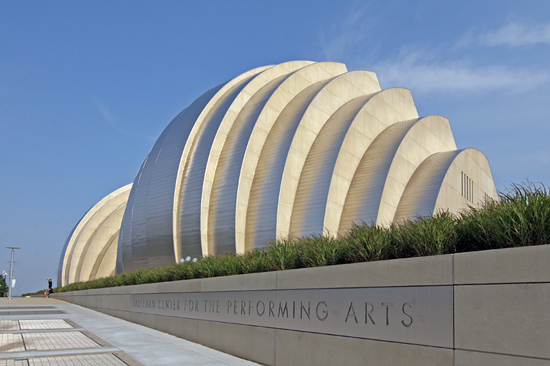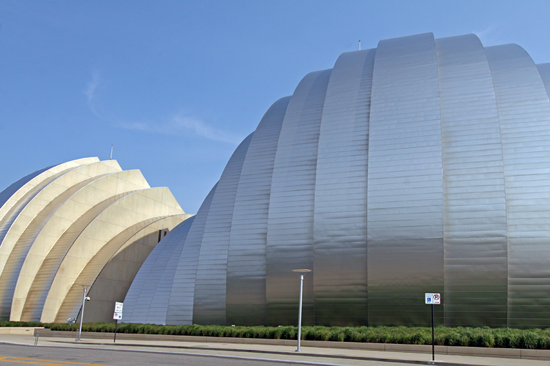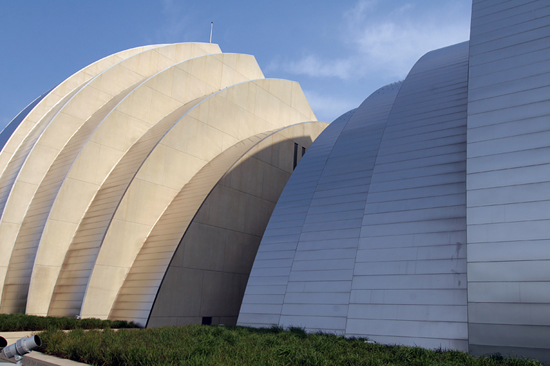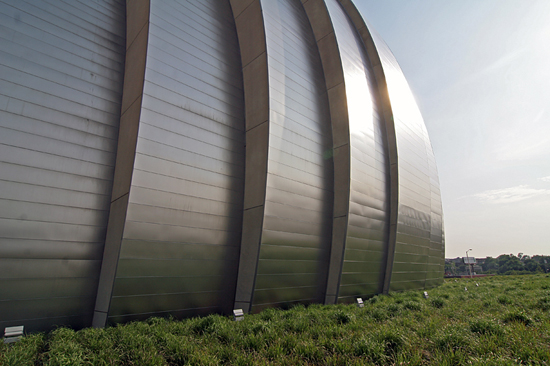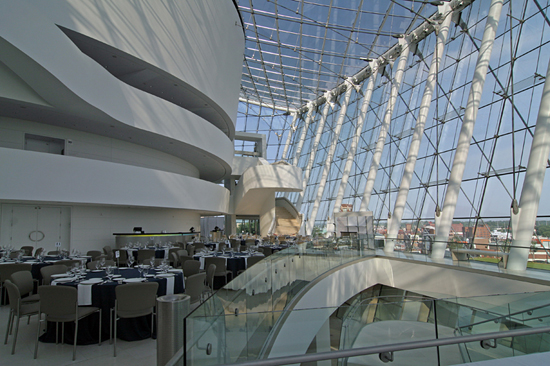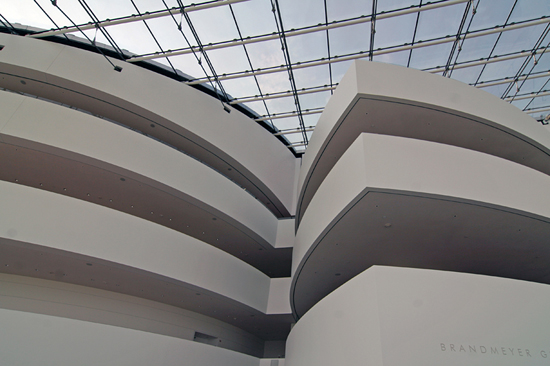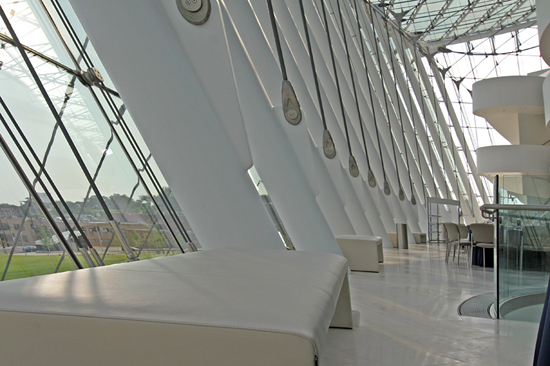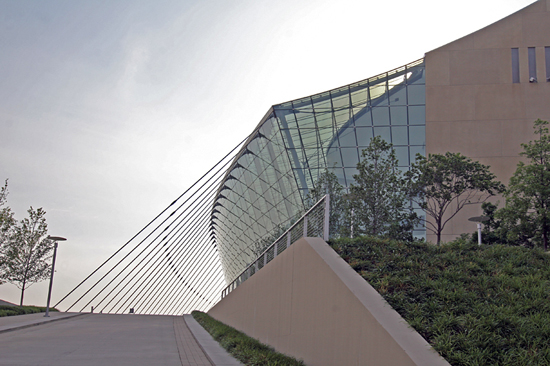Kauffman Center for the Performing Arts
Kansas City, MO
Over Memorial Day weekend 2012, I was part of a Kansas City, Missouri architecture adventure. The most towering experience was interacting with the Kauffman Center for the Performing Arts, which is the work of legendary architect Moshe Safdie.
It’s obviously a “wow” building. I was struck by how the shape of the building conjured the images of how sound waves ripple out. And all of the materials feel as good to the touch as they look to the eye. Then we got to go inside, which was a whole other experience. There was a hostess who gave us the informational spiel, which had fascinating details about construction and methodology.
As she was sharing this information, I drifted away to something more personal: how author Witold Rybczynski writing about a building of Moshe Safdie’s changed my life. If you are a regular or semi-regular reader of B.E.L.T., you are a recipient of how that sea change manifested itself. Everything I’ve done in the realm of architectural documentation is a direct and continual result of how inspiring Witold is. To stand in the building of a man who inspired (and hired) Witold was the convergence of so many layers of meaning as to be overwhelming. The meaning rippled out in waves much like the shape of the Kauffman Center.
In the very late 1990s, the first Witold Rybczynski I read was his book The Most Beautiful House in the World, a detailed chronicle of designing and building his very own home. Seeing Jackie O. read this book was a revelation! That led to his book Looking Around: A Journey Through Architecture, which was a compilation of previously published architectural critiques.
Everything else I was reading at this time (Architectural Record and Architect magazines plus the treatise of architects like Frank Lloyd Wright, Le Corbusier, etc. along with text books assigned in various architecture classes) was built on dense theories and opinions aimed at a select group of learned practitioners. I felt talked-down to, and even when deciphering what they possibly meant, I often disagreed with their views that felt dislocated from the real world where these buildings stood.
Rybczynski was like bumping into the only English-speaking person on a backpack tour of Romania. He spoke plainly and clearly with the engaged passion of a person who loves everything about every type of building, long after the architects and scholars have moved on to the next big thing.
He was clearly “one of them,” but intent on communicating with the people who didn’t have architectural degrees or command of theoretical jibber jab. A dialogue with people who actually used these buildings was more important to him than burnishing relations with architectural academia and press. Reading about the built environment in layman’s terms removed any insecurities about my reaction to and interpretation of the buildings I encountered. Witold was like a mind-expanding drug – he was liberation.
The most profound chapter, for me, of Looking Around was “Habitat Revisited.” Habitat is a Montreal, Canada apartment building by Moshe Safdie from 1967. Here’s what it looks like. About 25 years after its groundbreaking debut, Witold went back to see how it was holding up. He made the point that when an important building is first introduced, it is photographed in its fresh, pristine state, but that what matters most is how it ages, and how it serves the function it was built for.
Spend any time studying architecture and you run across this landmark building. At the point I was at in my architectural journey, Habitat was instantly categorized as concrete Brutalism, and I just didn’t care. But Witold was discussing not only the patina of time on its facade and landscape, but how the people who live there made it their own, and how living there elevates the residents’ daily lives.
Suddenly, a building I dismissed as freaky and cold sprang to life in a language I understood: how it affects the people who use it. By that criteria, this was a successful building. The human element changed how I perceived Habitat’s aesthetic, and I quickly realized that Safdie’s intentions were not merely academic drivel, but rather his achieved goal.
And suddenly, the tenets of modernism made sense. But it only matters if it works for the people who have to use it. Which is where I part with accepted architectural theory, practice and preservation. But I was no longer alone in this enlightenment, for I had Witold Rybczynski holding aloft his guiding lantern.
I won’t go on about all his wonderful work (except to say his book about staying in Palladio villas to figure out why they’ve worked for centuries – The Perfect House: A Journey with the Renaissance Master Andrea Palladio – is a swooning Must Read) because you can decide for yourself. Witold has a blog, he’s on Twitter, and you can learn about him and his books here. If you love architecture, and don’t know Witold, this could be a major discovery for you.
So this is the back-story on why standing in a building of an architect who was the inspiration of a mind-expanding chapter in a Rybczynski book over-stimulated by mind and nostalgia.
Another thing I learned from Witold was that you will never truly understand a building until you’ve seen it, experienced it. Reading about it and looking at pictures of it is only an introduction. Unfortunately, most of us don’t have the resources or connections to experience all the great buildings. But it’s OK to start with the buildings around you everyday, and expand from there.
In the case of the Kauffman Center, I only experienced part of it. It exists to house its theaters, and I didn’t even see those, much less experience how they work for an audience member. But the sections I saw are breathtaking, the ladies’ room was striking and efficient, and the building and its campus are as inviting as they are awe-inspiring.
Certainly those who have sat in the auditoriums or attended an event in the atrium would be a better judge of its worth as a performing arts center. It has captured the attention of KCers, who have lovingly documented every stage of its being. And I’d love to hear the thoughts of the crews who maintain the building (does winter-time ice come crashing down off those curves?). But in lieu of all that, I still loved being in and around the Kauffman Center. There was no denying it was a magnificent piece of architecture.
Here are extra photos from that visit.
The ripples of that day have lingered on, compelling me to pull out my Rybczynski books and re-visit what makes them so essential. I’m even reading his latest book, which is an engrossing story of client and architect creating an art museum. And another new shot of adrenalin was finding this video from April 2012 of Witold and Moshe reunited for a good chat about Safdie’s work. And here’s a Safdie quote from the video that perfectly sums up why Witold means so much to me:
“I’ve always admired how Witold brings architecture down to earth. No pretentions, clear thinking, just the ability to focus on what architecture does to our lives. And to write about it in a way that relates to both architects and laymen.”

